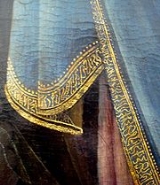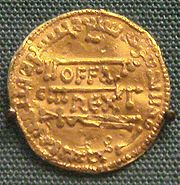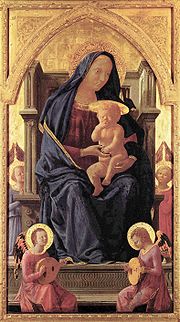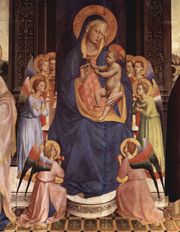
Pseudo-Kufic
Encyclopedia
Pseudo-Kufic, or Kufesque, also sometimes Pseudo-Arabic, refers to imitations of the Arabic Kufic
script, or sometimes Arabic cursive script, made in a non-Arabic context, during the Middle-Ages or the Renaissance
: "Imitations of Arabic in European art are often described as pseudo-Kufic, borrowing the term for an Arabic script that emphasizes straight and angular strokes, and is most commonly used in Islamic architectural decoration". Pseudo-Kufic appears especially often in Renaissance art in depictions of people from the Holy Land
, particularly the Virgin Mary. It is an example of Islamic influences on Christian art
.
 Some of the first imitations of the Kufic script go back to the 8th century when the English king Offa
Some of the first imitations of the Kufic script go back to the 8th century when the English king Offa
(r. 757–796) produced gold coins imitating Islamic dinars. These coins were copies of an Abbasid dinar struck in 774 by Caliph Al-Mansur
, with "Offa Rex" centred on the reverse. It is clear that the moneyer had no understanding of Arabic
as the Arabic text contains many errors. The coin may have been produced in order to trade with Islamic Spain
; or it may be part of the annual payment of 365 mancus
es that Offa promised to Rome.
In Medieval southern Italy
(in merchant cities such as Amalfi
and Salerno
) from the mid-10th century, imitations of Arabic coins, called tarì
, were widespread but only used illegible pseudo-Kufic script.
Examples are known of the incorporation of Kufic script and Islamic-inspired colourful diamond-shaped designs such as a 13th French Limoges enamel
ciborium at the British Museum
. The band in pseudo-Kufic script "was a recurrent ornamental feature in Limoges
and had long been adopted in Aquitaine
".
 Numerous instances of pseudo-Kufic are known from European art from around the 10th to the 15th century. Pseudo-Kufic inscriptions were often used as decorative bands in the architecture of Byzantine
Numerous instances of pseudo-Kufic are known from European art from around the 10th to the 15th century. Pseudo-Kufic inscriptions were often used as decorative bands in the architecture of Byzantine
Greece
from the mid 11th century to mid-12th century, and in decorative bands around religious scenes in French and German wall paintings from the mid-12th to mid-13th century, as well as in contemporary manuscript illuminations. Pseudo-Kufic would also be used as writing or as decorative elements in textiles, religious halos
or frames. Many are visible in the paintings of Giotto (c. 1267-1337).
From 1300 to 1600, according to Rosamond Mack, the Italian imitations of Arabic script tend to rely on cursive Arabic rather than Kufic, and therefore should better be designated by the more generalist term of "Pseudo-Arabic". The habit of representing guilted halos with decorated with pseudo-Kufic script seems to have disappeared in 1350, but was revived around 1420 with the work of painters such as Gentile da Fabriano
, who was probably responding to artistic influence in Florence
, or Masaccio
, who was influenced by Gentile, although his own script was "jagged and clumsy", as well as Giovanni Toscani
or Fra Angelico
, in a more Gothic
style.


 From around 1450, northern Italian artists also started to incorporate pseudo-Islamic decorative devices in their paintings. Francesco Squarcione
From around 1450, northern Italian artists also started to incorporate pseudo-Islamic decorative devices in their paintings. Francesco Squarcione
started the trend in 1455, and he was soon followed by his main pupil, Andrea Mantegna
. In the 1456-1459 San Zeno Altarpiece
, Mantegna combines pseudo-Islamic script in halos and garment hems (see detail), to depiction of Mamluk
book-bindings in the hand of San Zeno (see detail), and even to a Turkish carpet at the feet of the Virgin Mary (see detail).
The exact reason for the incorporation of pseudo-Kufic or pseudo-Arabic in Medieval or early Renaissance painting is unclear. It seems that Westerners mistakenly associated 13-14th century Middle-Eastern scripts as being identical with the scripts current during Jesus
's time, and thus found natural to represent early Christians in association with them: "In Renaissance art, pseudo-Kufic script was used to decorate the costumes of Old Testament
heroes like David". Another reason might be that artist wished to express a cultural universality for the Christian faith, by blending together various written languages, at a time when the church had strong international ambitions.
Pseudo-Hebrew is also sometimes seen, as in the mosaic
at the back of the abse
in Marco Marziale
's Circumcision, which does not use actual Hebrew characters. It was especially common in German works.
Finally pseudo-Arabic elements became rare after the second decade of the 16th century. According to Rosamond Mack: "The Eastern scripts, garments, and halos disappeared when the Italians viewed the Early Christian era in an antique Roman
context.".
Kufic
Kufic is the oldest calligraphic form of the various Arabic scripts and consists of a modified form of the old Nabataean script. Its name is derived from the city of Kufa, Iraq, although it was known in Mesopotamia at least 100 years before the foundation of Kufa. At the time of the emergence of...
script, or sometimes Arabic cursive script, made in a non-Arabic context, during the Middle-Ages or the Renaissance
Renaissance
The Renaissance was a cultural movement that spanned roughly the 14th to the 17th century, beginning in Italy in the Late Middle Ages and later spreading to the rest of Europe. The term is also used more loosely to refer to the historical era, but since the changes of the Renaissance were not...
: "Imitations of Arabic in European art are often described as pseudo-Kufic, borrowing the term for an Arabic script that emphasizes straight and angular strokes, and is most commonly used in Islamic architectural decoration". Pseudo-Kufic appears especially often in Renaissance art in depictions of people from the Holy Land
Holy Land
The Holy Land is a term which in Judaism refers to the Kingdom of Israel as defined in the Tanakh. For Jews, the Land's identifiction of being Holy is defined in Judaism by its differentiation from other lands by virtue of the practice of Judaism often possible only in the Land of Israel...
, particularly the Virgin Mary. It is an example of Islamic influences on Christian art
Islamic influences on Christian art
Islamic influences on Christian art refers to the influence of Islamic art, the artistic production in the Islamic world from the 7th to the 19th century, on Christian art. During this period, the frontier between Christendom and the Islamic world varied a lot resulting in some case in exchanges of...
.
Early examples

Offa
Offa may refer to:Two kings of the Angles, who are often confused:*Offa of Angel , on the continent*Offa of Mercia , in Great BritainA king of Essex:*Offa of Essex A town in Nigeria:* Offa, Nigeria...
(r. 757–796) produced gold coins imitating Islamic dinars. These coins were copies of an Abbasid dinar struck in 774 by Caliph Al-Mansur
Al-Mansur
Al-Mansur, Almanzor or Abu Ja'far Abdallah ibn Muhammad al-Mansur was the second Abbasid Caliph from 136 AH to 158 AH .-Biography:...
, with "Offa Rex" centred on the reverse. It is clear that the moneyer had no understanding of Arabic
Arabic language
Arabic is a name applied to the descendants of the Classical Arabic language of the 6th century AD, used most prominently in the Quran, the Islamic Holy Book...
as the Arabic text contains many errors. The coin may have been produced in order to trade with Islamic Spain
Al-Andalus
Al-Andalus was the Arabic name given to a nation and territorial region also commonly referred to as Moorish Iberia. The name describes parts of the Iberian Peninsula and Septimania governed by Muslims , at various times in the period between 711 and 1492, although the territorial boundaries...
; or it may be part of the annual payment of 365 mancus
Mancus
Mancus was a term used in early medieval Europe to denote either a gold coin, a weight of gold of 4.25g , or a unit of account of thirty silver pence. This made it worth about a months wages for a skilled worker, such as a craftsman or a soldier...
es that Offa promised to Rome.
In Medieval southern Italy
Italy
Italy , officially the Italian Republic languages]] under the European Charter for Regional or Minority Languages. In each of these, Italy's official name is as follows:;;;;;;;;), is a unitary parliamentary republic in South-Central Europe. To the north it borders France, Switzerland, Austria and...
(in merchant cities such as Amalfi
Amalfi
Amalfi is a town and comune in the province of Salerno, in the region of Campania, Italy, on the Gulf of Salerno, c. 35 km southeast of Naples. It lies at the mouth of a deep ravine, at the foot of Monte Cerreto , surrounded by dramatic cliffs and coastal scenery...
and Salerno
Salerno
Salerno is a city and comune in Campania and is the capital of the province of the same name. It is located on the Gulf of Salerno on the Tyrrhenian Sea....
) from the mid-10th century, imitations of Arabic coins, called tarì
Tarì
A tarì was the Christian designation of a type of gold coin of Islamic origin minted in Sicily, Malta and South Italy from about 913 to 1859.-History:...
, were widespread but only used illegible pseudo-Kufic script.
Examples are known of the incorporation of Kufic script and Islamic-inspired colourful diamond-shaped designs such as a 13th French Limoges enamel
Limoges enamel
Limoges enamel was produced at Limoges, France, already the most famous, but not the most high quality, European center of vitreous enamel production by the 12th century; its works were known as Opus de Limogia or Labor Limogiae...
ciborium at the British Museum
British Museum
The British Museum is a museum of human history and culture in London. Its collections, which number more than seven million objects, are amongst the largest and most comprehensive in the world and originate from all continents, illustrating and documenting the story of human culture from its...
. The band in pseudo-Kufic script "was a recurrent ornamental feature in Limoges
Limoges
Limoges |Limousin]] dialect of Occitan) is a city and commune, the capital of the Haute-Vienne department and the administrative capital of the Limousin région in west-central France....
and had long been adopted in Aquitaine
Aquitaine
Aquitaine , archaic Guyenne/Guienne , is one of the 27 regions of France, in the south-western part of metropolitan France, along the Atlantic Ocean and the Pyrenees mountain range on the border with Spain. It comprises the 5 departments of Dordogne, :Lot et Garonne, :Pyrénées-Atlantiques, Landes...
".
Renaissance painting

Byzantine
Byzantine usually refers to the Roman Empire during the Middle Ages.Byzantine may also refer to:* A citizen of the Byzantine Empire, or native Greek during the Middle Ages...
Greece
Greece
Greece , officially the Hellenic Republic , and historically Hellas or the Republic of Greece in English, is a country in southeastern Europe....
from the mid 11th century to mid-12th century, and in decorative bands around religious scenes in French and German wall paintings from the mid-12th to mid-13th century, as well as in contemporary manuscript illuminations. Pseudo-Kufic would also be used as writing or as decorative elements in textiles, religious halos
Halos
Halos was a settlement in Ancient Greece, in the region of Thessaly. It was destroyed by an earthquake and abandoned....
or frames. Many are visible in the paintings of Giotto (c. 1267-1337).
From 1300 to 1600, according to Rosamond Mack, the Italian imitations of Arabic script tend to rely on cursive Arabic rather than Kufic, and therefore should better be designated by the more generalist term of "Pseudo-Arabic". The habit of representing guilted halos with decorated with pseudo-Kufic script seems to have disappeared in 1350, but was revived around 1420 with the work of painters such as Gentile da Fabriano
Gentile da Fabriano
Gentile da Fabriano was an Italian painter known for his participation in the International Gothic style. He worked in various places in central Italy, mostly in Tuscany. His best known works are his Adoration of the Magi and the Flight into Egypt.-Biography:Gentile was born in or near Fabriano,...
, who was probably responding to artistic influence in Florence
Florence
Florence is the capital city of the Italian region of Tuscany and of the province of Florence. It is the most populous city in Tuscany, with approximately 370,000 inhabitants, expanding to over 1.5 million in the metropolitan area....
, or Masaccio
Masaccio
Masaccio , born Tommaso di Ser Giovanni di Simone, was the first great painter of the Quattrocento period of the Italian Renaissance. According to Vasari, Masaccio was the best painter of his generation because of his skill at recreating lifelike figures and movements as well as a convincing sense...
, who was influenced by Gentile, although his own script was "jagged and clumsy", as well as Giovanni Toscani
Giovanni Francesco Toscani
Giovanni Francesco Toscani was an Italian painter.Born in Florence, he was the pupil of Giottino, in whose style he painted. His masterpiece is said to have been an Annunciation for a chapel of the Bishop's palace in Arezzo. It was restored by Agnolo di Lorenzo, and later by Vasari. Toscani was...
or Fra Angelico
Fra Angelico
Fra Angelico , born Guido di Pietro, was an Early Italian Renaissance painter described by Vasari in his Lives of the Artists as having "a rare and perfect talent"...
, in a more Gothic
Gothic art
Gothic art was a Medieval art movement that developed in France out of Romanesque art in the mid-12th century, led by the concurrent development of Gothic architecture. It spread to all of Western Europe, but took over art more completely north of the Alps, never quite effacing more classical...
style.



Francesco Squarcione
Francesco Squarcione was an Italian artist from Padua. His pupils included Andrea Mantegna , Cosimo Tura and Carlo Crivelli...
started the trend in 1455, and he was soon followed by his main pupil, Andrea Mantegna
Andrea Mantegna
Andrea Mantegna was an Italian painter, a student of Roman archeology, and son in law of Jacopo Bellini. Like other artists of the time, Mantegna experimented with perspective, e.g., by lowering the horizon in order to create a sense of greater monumentality...
. In the 1456-1459 San Zeno Altarpiece
San Zeno Altarpiece (Mantegna)
The San Zeno Altarpiece is a triptych by the Italian Renaissance painter Andrea Mantegna, from c. 1457-1460. It is located in the Basilica di San Zeno, the main church of Verona. The three predellas were stripped by the French in 1797, and are now replaced by copies...
, Mantegna combines pseudo-Islamic script in halos and garment hems (see detail), to depiction of Mamluk
Mamluk
A Mamluk was a soldier of slave origin, who were predominantly Cumans/Kipchaks The "mamluk phenomenon", as David Ayalon dubbed the creation of the specific warrior...
book-bindings in the hand of San Zeno (see detail), and even to a Turkish carpet at the feet of the Virgin Mary (see detail).
The exact reason for the incorporation of pseudo-Kufic or pseudo-Arabic in Medieval or early Renaissance painting is unclear. It seems that Westerners mistakenly associated 13-14th century Middle-Eastern scripts as being identical with the scripts current during Jesus
Jesus
Jesus of Nazareth , commonly referred to as Jesus Christ or simply as Jesus or Christ, is the central figure of Christianity...
's time, and thus found natural to represent early Christians in association with them: "In Renaissance art, pseudo-Kufic script was used to decorate the costumes of Old Testament
Old Testament
The Old Testament, of which Christians hold different views, is a Christian term for the religious writings of ancient Israel held sacred and inspired by Christians which overlaps with the 24-book canon of the Masoretic Text of Judaism...
heroes like David". Another reason might be that artist wished to express a cultural universality for the Christian faith, by blending together various written languages, at a time when the church had strong international ambitions.
Pseudo-Hebrew is also sometimes seen, as in the mosaic
Mosaic
Mosaic is the art of creating images with an assemblage of small pieces of colored glass, stone, or other materials. It may be a technique of decorative art, an aspect of interior decoration, or of cultural and spiritual significance as in a cathedral...
at the back of the abse
Abse
Abse is a Welsh surname, and may refer to:*Dannie Abse , Welsh writer and physician*Joan Abse , English art historian*Leo Abse , Welsh politician*Wilfred Abse , Welsh psychiatrist...
in Marco Marziale
Marco Marziale
Marco Marziale was an Italian painter from Venice, known to have been active from 1492/1493 to 1507. He was a pupil of Giovanni Bellini, as stated in some of his inscriptions signing works, and was also influenced by Giovanni's bother Gentile, with possibly some elements of the style of Perugino also...
's Circumcision, which does not use actual Hebrew characters. It was especially common in German works.
Finally pseudo-Arabic elements became rare after the second decade of the 16th century. According to Rosamond Mack: "The Eastern scripts, garments, and halos disappeared when the Italians viewed the Early Christian era in an antique Roman
Ancient Rome
Ancient Rome was a thriving civilization that grew on the Italian Peninsula as early as the 8th century BC. Located along the Mediterranean Sea and centered on the city of Rome, it expanded to one of the largest empires in the ancient world....
context.".
See also
- Islamic contributions to Medieval EuropeIslamic contributions to Medieval EuropeIslamic contributions to Medieval Europe were numerous, affecting such varied areas as art, architecture, medicine, agriculture, music, language, and technology. From the 11th to 13th centuries, Europe absorbed knowledge from the Islamic civilization...
- Thematic development of Italian Renaissance paintingThematic development of Italian Renaissance paintingThis article about the development of themes in Italian Renaissance painting is an extension to the article Italian Renaissance painting, for which it provides additional pictures with commentary...
- Oriental carpets in Renaissance paintingOriental carpets in Renaissance paintingCarpets of Middle-Eastern origin, either from the Ottoman Empire, Armenia, Azerbaijan, the Levant or the Mamluk state of Egypt or Northern Africa, were used as important decorative features in paintings from the 14th century onwards...

